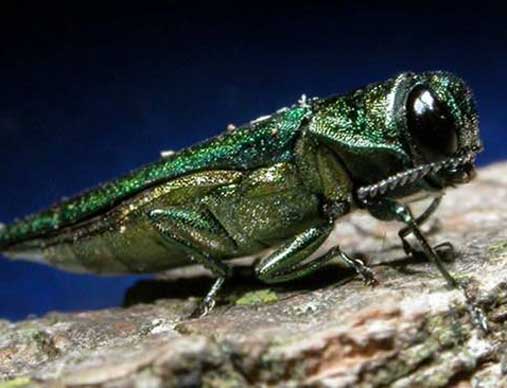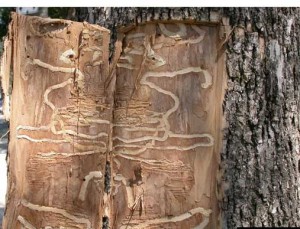
While there is no proof they’ve made it to Kansas City, tree experts suspect emerald ash borers are already doing damage to Midtown trees. Source: Missouri Department of Conservation.
Posted by Joe Lambe
The dreaded emerald ash borer has not been spotted in Midtown yet, but the bug that murdered up to 100 million ash trees is likely here or on its way.
The trees have died since the invasive species was found in the Detroit area a decade ago, and now the ugly green insects are confirmed in Platte and Wyandotte counties.
Tree experts hunting the tiny bugs in Kansas City so far have not found them, but say they could well be here already or they soon will be.
Wendy Sangster, urban forester with the Missouri Department of Conservation, said she and other hunters have not had bucket trucks, which are needed to check the tops of trees.

When bark from an ash tree is peeled away, galleries bored by the insect can be seen. Source: Missouri Department of Conservation.
And that is where the bugs start, she said. “Until it is really infested you’re not going to see a sign on the bottom of the tree.”
Expect the worst, she said, with damage to ash trees comparable to the Dutch elm disease that killed elm trees beginning in the 1960s.
Up to seven million ash trees in the nine-county metropolitan area are in severe danger, Sangster said.
And there will be major expense to cities and suburban developments, many of which extensively planted ash trees in the last three decades. Kansas City and other cities often planted them to replace the dead elms, she said.
Many suburban developments also planted them almost exclusively because they seemed a safe bet. So they are everywhere from shading lavish homes to lining Southwest Trafficway to lining the parking lot of the Costco at Linwood and Main.
While ash trees account for only four out of 100 trees in the native forests of Missouri, they comprise up to 25 percent of the trees in some parts of cities, the conservation department reports.
Treating the trees with insecticides to try to save them sometimes works, but it is expensive and must be repeated regularly, Sangster said.
The department does not recommend treatment until infestation has been found within 15 miles of a location. The Platte County insects were found just north of Parkville, which is about 15 miles from Midtown.
Insecticide use could become a 20-year commitment or longer until the ash dies and a replacement tree planted near it can take its place, the department reports.
You might think twice about making that replacement a maple, which is a favorite entrée for another invasive tree-killer: the Asian long-horned beetle.
“It’s always something,” Sangster said, and that is why the conservation department urges cities to plant many different kinds of trees.



Who’s talking